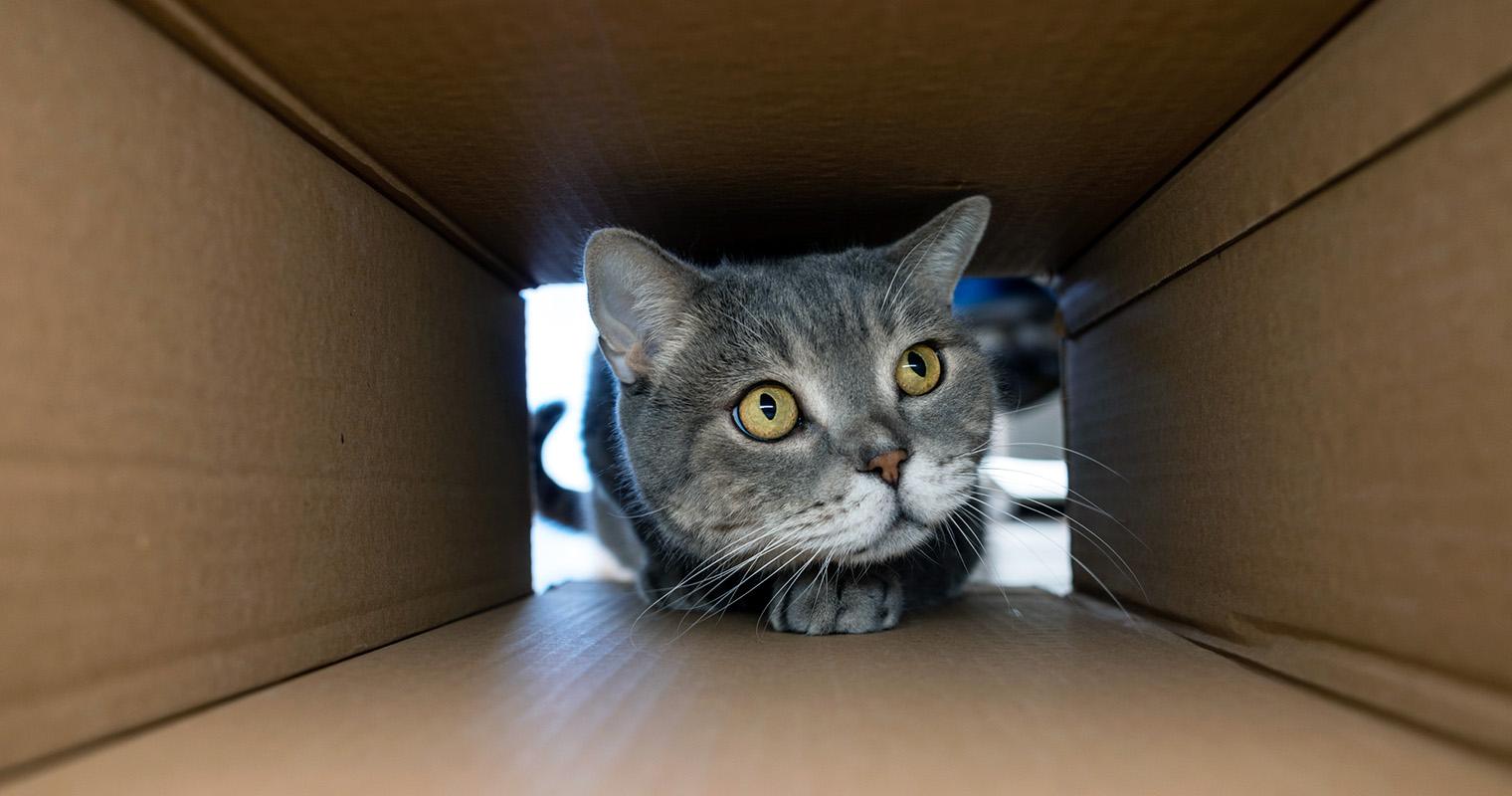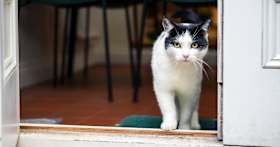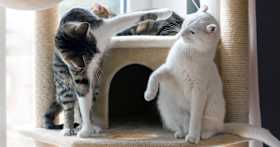How Much Space Does a Cat Need to Be Happy?
Cats may not need a lot of space, but it’s what you do with it that matters. Read on for tips to keep your cat mentally and physically at ease.
Cats may not need a lot of space, but it’s what you do with it that matters. Read on for tips to keep your cat mentally and physically at ease.
by Katie Koschalk, | March 9, 2024

101cats / iStock
You’re probably familiar with cats’ affinity for cramming themselves into snug spots like shoeboxes, containers, and even vases (aka “If it fits, I sits”). But when it comes to overall living space, cats need a bit more room, though probably not as much as you’d think. So, just how much space does a house cat need?
While the exact space requirements vary based on breed, age, and personality, providing at least 200 square feet of living space for a single cat is advisable. That said, the exact square footage is not as important as ensuring they have enough room and stimulation to meet their unique needs. Let’s break this down further.
First things first, it’s important to acknowledge that some online publications suggest a minimum of 18 square feet as necessary space for a single cat. However, this figure originates from regulations governing minimum-space requirements for cats in shelters, rescues, or breeding conditions. In reality, a house cat will need a larger space to thrive — at least 200 square feet, as mentioned above.
But that figure isn’t a hard rule. When determining how much space a cat needs to be happy, several factors come into play, which could slightly increase or decrease the necessary square footage.
Different cat breeds have varying levels of activity and space requirements. For instance, energetic breeds like Bengals and Abyssinians typically need more space to burn off their excess energy through play and exploration, while more laid-back breeds like Persians may be content with a smaller area. Consider the characteristics of your cat’s breed (or breed mix) when assessing their spatial needs.
Kittens and younger cats are typically more active and playful, requiring ample space to run, climb, and explore. As they grow into full-fledged adults, cats may become less active but still appreciate having adequate room to move around, play, and unleash the occasional zoomie. Older cats tend to be less active and might not need as much space for play and exploration, often preferring quieter, more secluded spaces for rest.
A healthier cat is inclined to explore, so having more available space is not lost on them. In contrast, cats with disabilities or health issues may have smaller spatial needs, particularly if their mobility is less than that of an average cat. Other felines might require special accommodations that take up space, such as ramps, so be sure to factor in that, too.
Just like humans, cats have distinct personalities and temperaments that influence their needs. Some cats are outgoing and adventurous, thriving in environments with plenty of opportunities for exploration. Others may be more reserved or shy, preferring quiet, secure spaces where they can retreat or observe their surroundings from a cozy perch. Understanding your cat’s personality can help you create a living environment that caters to their individual needs and preferences.
Your living space’s overall environment plays a huge role in your cat’s needs. For instance, a smaller living area that maximizes vertical space, incorporating features like cat perches, climbing structures, or even a cat “superhighway,” offers superior enrichment compared to a larger, open space without such amenities.
It’s also important to factor in how many cats reside in your home. Adding about 100 square feet of living space for each additional cat is a good rule of thumb. Additional considerations include other pets in the household (dogs, birds, reptiles, etc.), other people in the household, and the layout of your home.
Bringing a cat into a new environment can be a daunting experience for both you and your feline companion. However, with careful consideration of how to use your home’s space, you can create a layout in which your cat feels safe, secure, and comfortable. Here are some key tips to implement, once you’ve graduated past making your cat’s first day home as smooth as possible.
Establish a designated eating area for your cat in a quiet, low-traffic area of your home. Provide food and water bowls that are easily accessible and kept clean.
Place the litter boxes in quiet, private locations where your cat can easily access them. The boxes should be kept far away from a cat’s eating area to prevent any aversions (you wouldn’t want your toilet in your kitchen, right?). Scoop the litter box twice a day, and do a complete clean every two to three weeks to prevent odors and keep things nice and tidy.
Provide one litter box per cat, plus an extra one (i.e. two boxes for one cat, three boxes for two cats, etc). And consider using unscented litter to avoid overwhelming their sensitive sense of smell.
Create at least two cozy, comfortable sleeping areas for your cat where they can retreat and rest. Place the cat beds or blankets in quiet corners or slightly elevated locations where they’ll feel safe and secure.
To ensure your indoor cat gets sufficient mental and physical stimulation, create an enriching indoor environment. Provide opportunities for play and exploration by setting up interactive toys, scratching posts, ripple rugs, tunnels, puzzle feeders, and climbing structures.
Regardless of where your cat came from, it’s recommended that you keep them indoors. This protects them from hazards such as traffic, predators, and diseases. Indoor cats tend to have fewer health issues and live longer than outdoor cats (10-15 years vs. 2-5 years). You can still provide your cat with safe outdoor experiences by cat-proofing your backyard or creating a “catio.” These enclosed outdoor spaces allow your kitty to enjoy fresh air, sunshine, and the sights and sounds of nature, while remaining protected from potential dangers.
Cats can live happily in smaller living spaces like apartments or tiny homes, but the trick is to create a territory that’s bigger than just the floor. Investing in tall scratching posts, cat trees, shelves, and wall-mounted perches allows you to capitalize on unused vertical space.
These vertical elements greatly expand your cat’s world and encourage natural behaviors, such as climbing, jumping, and perching. Just make sure these structures are stable enough to hold your cat and are not near anything that could cause them harm (such as electrical wires or other unsteady or breakable objects).
Before bringing a new cat into your home, you’ll need to purchase several items. These include food and water bowls, litter boxes, a cat bed, a scratching post, toys, grooming supplies, and a cat carrier.
To create a cat-friendly home, provide vertical spaces like shelves or cat trees, toys, scratching posts, and cozy areas for sleep. Set up an eating station, and place litter boxes away from it. Also, consider a “catio” for safe outdoor access.
A cat can live in one room as long as the room is safe, at least 200 square feet, and enriched with vertical spaces for climbing, scratching posts, and toys. Frequent, loving attention is also crucial for the cat’s emotional well-being.
If you have enough living space to accommodate a cat, explore Adopt a Pet’s customizable search tool to find your new family member.
AAFP and ISFM Feline Environmental Needs Guidelines
Code of Federal Regulations - Part 3 Standards
Environmental Enrichment for Indoor Cats
A Game of Cat and House: Spatial Patterns and Behavior of 14 Domestic Cats (Felis Catus) in the Home

Katie Koschalk is a freelance writer based in Northern California. Fusing her love and knowledge of animals with her journalism degree and years of professional writing, Katie is dedicated to improving the lives of pets and their caretakers by sharing helpful and accurate information. When she’s not at her desk, you can find her exploring trails with her Aussie, Hunter, cooking plant-based meals, and talking to her two cats, Jax and Sadie, in really ridiculous voices.

Behavior & Training

Pet Wellness

Breed Info

Behavior & Training
The road to getting your cat and dog to get along can be rough. Thankfully, there are easy steps you can take to make it way less rocky.

Foster & Volunteer
Kitten season is coming! During the warmer months, kitten births skyrocket — and it has a dramatic effect on shelters.

Behavior & Training

Behavior & Training

Adoption Advice
These giant guinea pigs are smart and social, so what could go wrong? Read on to better understand why these animals don’t make good pets, and why they’re outlawed in several places.

Behavior & Training